8-1-10
Oscar Ruiz Navia’s Crab Trap: Myths in a Minor Key
By Diane Sippl
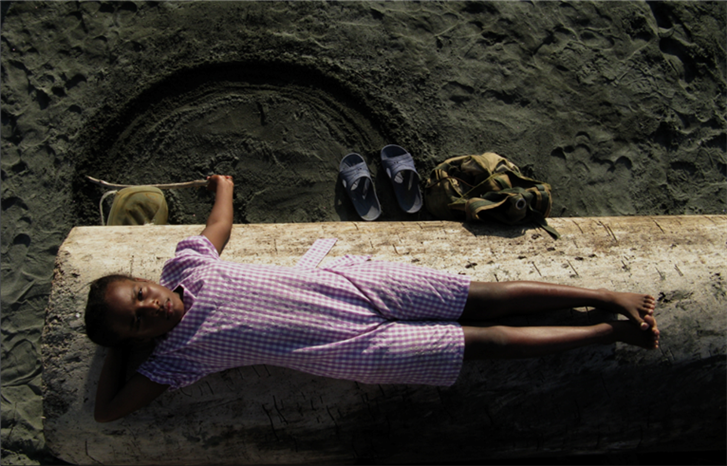
A curious image lingers in the pre-credit sequence of Crab Trap (El vuelco del cangrejo), a stunning feat of neo-existential, “post-exotic” cinema by Colombian writer-director Oscar Ruiz Navia. In the mucky earth, perhaps along a jungle river or en route to the sea, an out-sized shoe print draws the camera near. A puddle has filled its hollow, and from it a tiny creature struggles to crawl out. We then follow a tall, lean man with a fashionably bald head, wearing tight jeans and sporting a backpack, as he slips and slides in the mud. A rhyming image of the shoe print occurs later in the film: a pair of rain boots hangs upside down as if to dry in the sultry air just when we hear on television that people have been marching to Cali to meet the President to protest paramilitary “protection.” Precisely whose footprint has been left in the mud? It’s a question we ponder well past the black screen that brings the end credits but also yields a particular sound we’ve been waiting to hear.
If Odysseus’ boat had drifted off-course to the “New World,” would he ever have made it back to Penelope? In Oscar Ruiz Navia’s corner (albeit many centuries later), he might have looked more like the emaciated, shipwrecked Cabeza de Vaca out of Nicolás Echevarría’s eponymous Mexican film (1991), his encounters including African slaves such as those in Gillo Pontecorvo’s Burn! (1969) or Tomás Gutiérrez Alea’s The Last Supper (1976). But the residents of the black community who were pushed into the seaside jungle of La Barra on Colombia’s Pacific coast laid claim to their own stretch of beach and formed this remote fishing village long ago. It’s only recently that electricity has arrived in La Barra, and fast on its heels, an intruder with pasty white skin and carrot-colored hair (Jaime Andres Castaño) comes to blast the inhabitants away with the relentless noise of his techno music over loudspeakers he aims at them night and day. It’s just the beginning of his assault on their quietude: he’s building a disco-hotel with a swimming pool from his ramshackle hut because not only does he have papers dispensing the land to him, but he has money. So then, he has the only available fish.
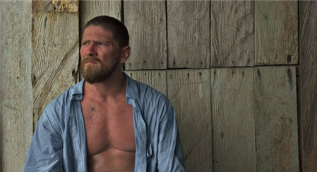
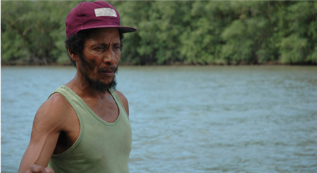
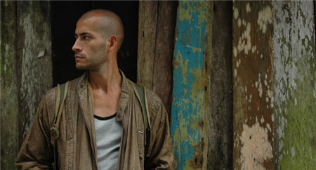
The locals have been living on rice and coconut milk since they depleted the nearby waters of the historic catch. “Out-of-towners came and fished indiscriminately, and our own people fished all year long. When you take but don't give, there's no way to produce,” observes one of the elders (Arnobio Salazar Rivas), nick-named “Cerebro” (“Brain”), and now the men have to go so far out to sea to find their haul, there’s no telling when they’ll return.
Into this setting, as if washed up by the waves, strays the bald-headed city dweller, Daniel (Rodrigo Vélez), discretely asking everyone where he can find a boat so as to get back on course again and reach his destination. So he, too, must wait — for the fishermen, for their catch, for a way out….
When Cerebro agrees to put him up in exchange for clearing the debris on the beach left by nature and tourists alike, Lucía (Yisela Álvarez), a girl who is not the first to solicit the stranger’s attention, nags him to come to her mother, Jazmin (Karent Hinestroza), “for lunch.” The villagers sell whatever they can, and Jazmin’s baby is hungry and crying. Meanwhile Paisa, the carrot-top public enemy number one, is happy to provide her with fish in exchange for “dance lessons”— that is, until Cerebro, her uncle, organizes the council members to destroy Paisa’s advances, stake their own ground, and recover their peace.
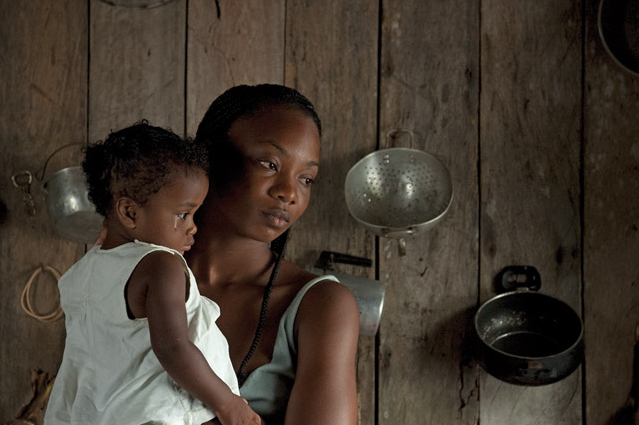
Such is the logistical turf of Crab Trap, a scenario sounding so familiar that any geography or history or social studies student could predict its outcome. Not only that, the film proceeds with the characters playing themselves, especially the locals, on their own home soil, in a conflict that actually occurred and that they have directly experienced. Why is it, then, that we feel we are watching “the stuff that myths are made of” — in particular, a seafarer’s voyage or a jungle story in which sirens and sorcerers stir up trouble along the tortuous path of a hero who unwittingly angers the gods and mortals alike? The fates — call them Westernization or Modernization — are out in force, and the innocents will be sacrificed. Unless, that is, “the people” rise up in a 20th-century-style revolution while the Colombian paramilitary slashes its way forward in a 21st-century “defense” against drug moguls, violence, and global greed.
Paradoxes abound in Crab Trap, from its mode of production to its characters and themes to its form and style. “We don’t like photographers. They make money on us and forget about La Barra. And they can cast a spell on you with the pictures. Several people have died by witchcraft. I don’t let anyone take pictures of me,” claims one of the girls at Lucía’s aunt’s house, where Lucía lines up her cousins one by one, according to height and age, to comfort the seated Daniel, a reluctant guest, by massaging his bald head, for starters. “I don’t like pictures taken by foreigners,” another cousin chimes in. Both girls speak these lines directly to the camera — a “return of the gaze,” if you will, that is equally defiant and baffling, given the fact that these lay actors are clearly complicit with their roles in this film by a white urbanite from Cali who is well outside their community.
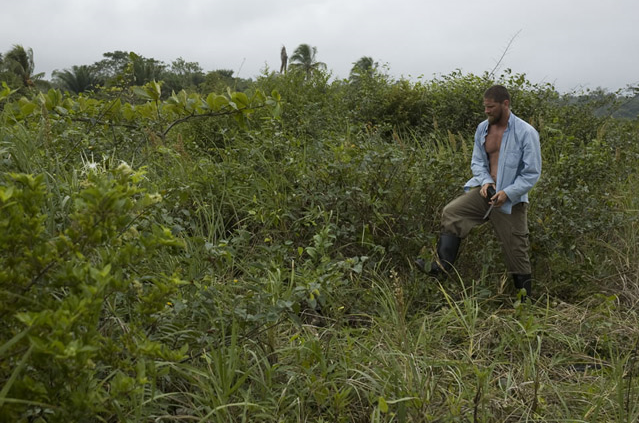
These girls might be the first to seek work at the tourist trap hotel that Paisa, the foreigner, is building, and they may well have been among those who first pleasantly greeted Oscar Ruiz Navia when he made his initial visit to La Barra as an outsider seeking a special vacation with his friends. “We liked the place because it was isolated and wasn’t overrun by tourists,” he has said at film festivals. It was “a calm place to relax, but you could also have an anthropological encounter with the native Afro-Colombians.”
Yet Daniel himself feels “trapped” by these girls and leaves before “lunch”; in his solitude he draws in his sketchbook as if to record the images that surround him. Meanwhile the film cuts to another trap, the one for boys — the ubiquitous TV set, a new novelty in homes and bars, where males can consume Colombian-style violence, whether it be in homegrown or dubbed programs, exploits that form a pervasive subtext in the film. This media self-reflexivity in Crab Trap carries over into popular music on the radio in the cantina. Yet it works in noticeable tension with the evocative chants by Cerebro and company at the campfire where, like a tribal griot with a talking drum, he calls on the spirits for the fishermen’s safe return. “The sea is angry with us for being aggressive,” he explains.
Is it the movie camera, or the TV, or the incantations of loco “King” Cerebro (as he is known) that conjures spells for girls, boys, adults, and even visitors in La Barra? It might be the sea, at least as it affects Daniel, the waylaid soul who is foreign to these parts (a likely stand-in for the film’s writer-director) and is lured to the waves and the moody, cloudy reflections as if into the arms of an embrace.
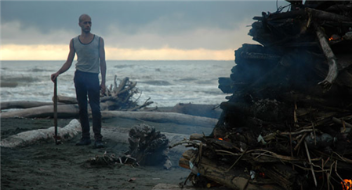
A dream sequence opens as Daniel
dips into the sea. Under water, he hears women chanting. His estranged
lover, or at least the woman in his personal photographs, is swimming in the
middle of the ocean beside Yazmin with her baby in her arms. The woman
stares directly into the camera, treading water, and then drifts out of the
frame to the left. We next see Daniel at Yazmin’s “table.”
Pre-teen Lucía, a sea nymph in her own right, beckons to Daniel to take her with him, for “purposes of domestic duties,” on the boat she’ll find for him; she won’t charge him for lunch. The pint-size siren truly won’t leave him alone and manages to milk more self-revelation from him than anyone else does. “I can’t stand that you're mad at me all the time,” she flirts to his glowering face.
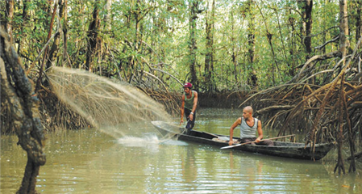
For her only, he is willing to contort that face to mime a variety of cock-eyed characters that at once charm a wild giggle from her and disclose his real-life calling as an actor. Thus he, too, is playing himself.
Whoever Daniel is (it seems we are not destined to know), he serves as a barometer for the pressure-cooker climate of La Barra, getting himself into just enough trouble to shore up the issues that divide those who dwell on this never-sunny beach. “Someone robbed me,” he reports to Cerebro, just when there seemed to be a boat for escape. But the “Brain” knows better: “Maybe you spent all your money at Paisa’s last night.” Cerebro, referring to Daniel’s boozing, smoking, and consorting with the enemy, orders Daniel to vacate his room and to leave La Barra. All of the village council stands behind this leader.
“To assault the medical mission is to assault the security of a people. Play fair. Respect the rules of war…” a loud speaker blasts, as if counter-poised with Paisa’s blaring songs. In a syncopated montage, the villagers’ doors and windows successively clack shut in Daniel’s face; when he passes by the one open doorway, Paisa’s, he sees him in tandem with Jazmin from behind. “Do you know what rhythm is?” she taunts her partner, performing a slow, sumptuous counter-rhythm to that of Daniel’s frantic flight.
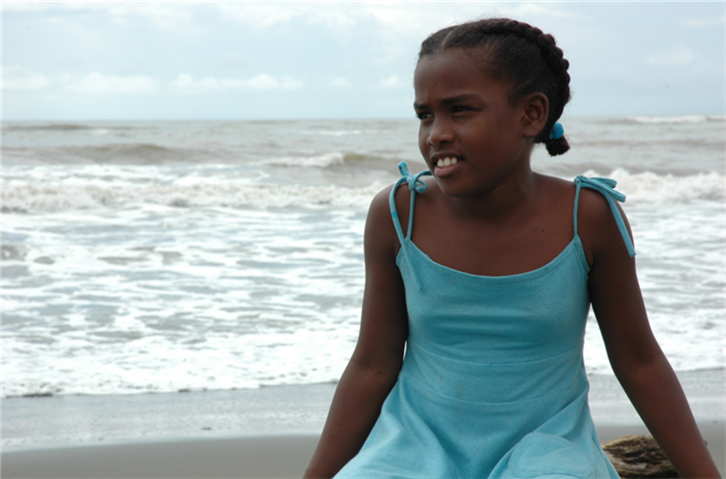
Earlier on the beach, Lucía showed Daniel how she catches crabs by turning them over on their backs so they can’t escape. Now she finally leads him to the boat she’s stowed away for him, and soon there is Daniel floating in the middle of the sea, alone at the bow of his boat — on his back.
On the beach where Paisa had hired the natives to build a wood fence sealing off their land for him, Cerebro arrives. Capping a distinctive camera style that often holds the lens still as action enters the frame, this shot awaits Cerebro, who enters it singing, “I’m not from this place; I just arrived. I hear the drums, like a celebration, a celebration…” One by one, his fellow councilmen come to stand beside him. When the screen cuts to black to end the film’s images, we hear the rhythmic, repetitive thud of the blades of machetes sinking into wood…
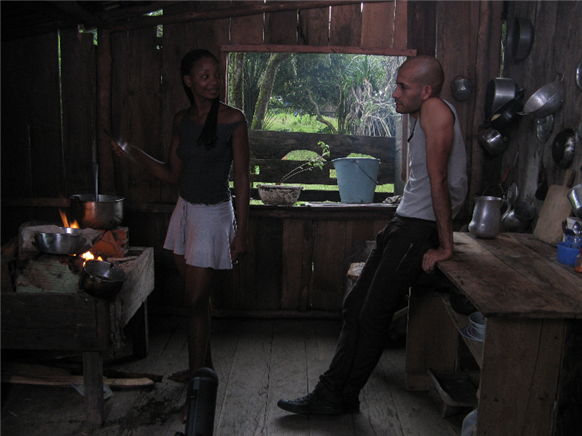
With a finely calibrated tempo, Oscar Ruiz Navia orchestrates time in Crab Trap as past, present, and future in a single moment — a moment when, as he has written, “in a land reeling and staggering from the paradox of progress… the creatures of the region are caught and flipped onto their backs, unable to move.” While some follow the “urge to escape in search of a new path,” others seek “to re-write what has been lost or forgotten.” In creating his film, this writer-director has embarked on both odysseys by forging new myths from the poetry of everyday life in La Barra.
Nature makes its own music in such a place, the usual filmic score here supplanted by the sounds of the wind in the palms, the rain on thatched roofs, the wild screech of insects and birds along the inland river where Cerebro asks Daniel, “Hear it? If you stay quiet for more than five minutes, you go crazy.” Cerebro’s tamboras and his friend’s marimba generate the only unmediated musical performance within the film, the patacoré, a dance of religious inspiration from Colombia’s southern Pacific coast, here first performed to honor the fishermen, but later, with the same lyrics sung in the same place, used for counterpoint as the councilmen chop down Paisa’s fence. Juxtaposed with Paisa’s techno music and the local tune, “The Story of a Guerrilla and a Paramilitary” by Uriel Henao, heard on the radio in Paisa’s bar, the patacoré is also surrounded by soaps and action films on TV and Colombian news bytes, all delivered via consumer electronics here, in this last outpost, La Barra.
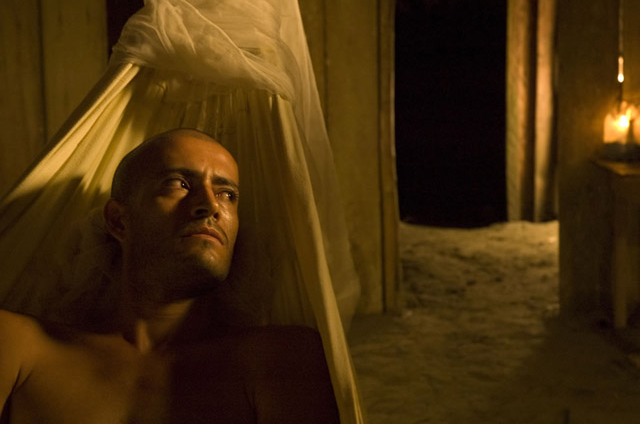
If Tarkovsky’s sense of cinema as “sculpting in
time” informs Ruiz Navia’s openness in the use of images, then Kiarostami and
Bresson inspire his approach to working with actors — marginal people who are
the real inhabitants of a peripheral location and, in being themselves, may rub
up against outsiders, the only professional actors in the film. Along the path of other Latin Americans in
this decade, Carlos Reygadas and Lisandro Alonso, to name two, Ruiz Navia mixes
the formal techniques of fiction and documentary cinema to create his
mysterious, meditative film, steeped in atmosphere and irony.
As if subjects in a documentary study, the boys of La Barra gawk candidly at the camera as they pass the ball in playing soccer or pass the bottle in talking about sex and girls, while Daniel all but interviews them, half-drunk himself. Even Jazmin's baby, plopped on the ground, cries, directly confronting the camera and pointing to her issue: Paisa baiting Jazmin with fish. Yet in a classical theatrical chase scene at the water's edge, the camera speed and the soundtrack become subtly surreal, privileging Lucía’s emotional point of view.
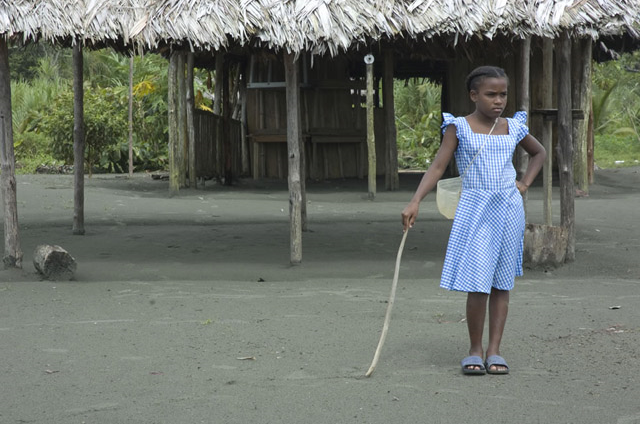
Crab Trap’s narrative is generally a re-enactment of actual events in La
Barra beginning in 2002 when
Ruiz Navia first met the villagers. With
their consent and participation, that visit precipitated a six-year process of
mutual acquaintance and collaboration including a short film, En la Barra hay un Cerebro (There Is a Brain in La Barra) in 2006
and also two-and-a-half years of swimming, tussle, and play between Rodrigo
Vélez (playing Daniel) and Yisela Álvarez (as Lucía) so that they could grow
comfortable with each other and work from their shared memories to generate
spontaneous dialogue during the filming. (This is both fitting and ironic,
since Vélez has remarked that the more familiar he became with La Barra, the
more estranged he felt.) Clearly, Yisela Álvarez felt no inhibitions in being either herself or her character as she honed a masterful presence/performance.
Meanwhile Oscar Ruiz Navia, who studied at the National Film and TV School of Colombia and then graduated in Social Communication from Valley University, formed his own production company in Cali in 2006, Contravía Films, making five other short films — fictional, documentary, and experimental. Crab Trap is his first feature film and is a magnificent contribution to the output of Colombia and Latin America alike. World cinema welcomes his artistic gifts and initiatives right alongside of those by the icons he might deem his mentors.
“It is a challenge to portray multiple artistic, social, ideological and philosophical conceptions in one film. However, for me it is essential to believe that cinema is constantly renewing itself. I think it is possible to create other forms of representation of life beyond the empty models forced on us daily by the media. As an art form, cinema is currently underused, and many of us thirst for more. When do we start?”
Oscar Ruiz Navia, Open
Doors, Festival
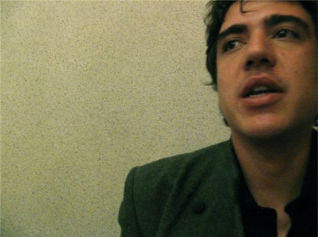
Writer-director-producer Oscar Ruiz Navia
Crab Trap
Director: Oscar Ruiz Navia; Producers: Diana Bustamante Escobar, Guillaume de Seille, Oscar Ruiz Navia, Gerylee Polanco; Screenplay: Oscar Ruiz Navia; Cinematographers: Sofía Oggioni Hatty, Andrés Pineda; Editor: Felipe Guerrero; Sound: Miguel Vargas, Frédéric Thery, Isabel Torres; Art Director: Marcela Gómez Montoya.
Cast: Rodrigo Vélez, Arnobio Salazar Rivas “Cerebro,” Jaime Andrés Castaño, Yisela Álvarez, Karent Hinestroza, Miguel Valoy, Israel Rivas.
Color, 35mm, 95 min. In Spanish with English subtitles.